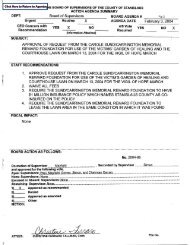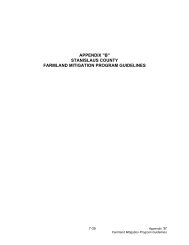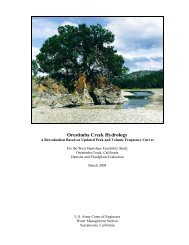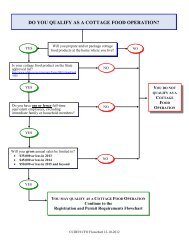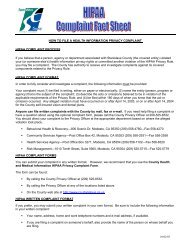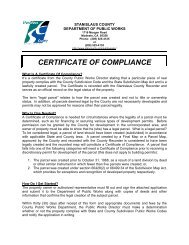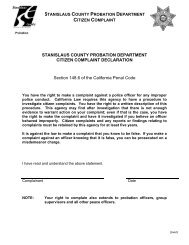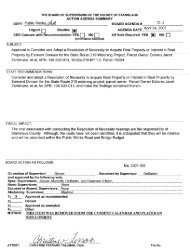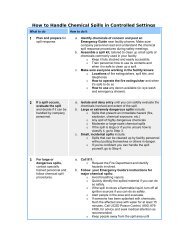Orestimba Creek Feasibility Study - Stanislaus County
Orestimba Creek Feasibility Study - Stanislaus County
Orestimba Creek Feasibility Study - Stanislaus County
You also want an ePaper? Increase the reach of your titles
YUMPU automatically turns print PDFs into web optimized ePapers that Google loves.
Economics Appendix – Draft Report - <strong>Orestimba</strong> <strong>Creek</strong> <strong>Feasibility</strong> <strong>Study</strong>, <strong>Stanislaus</strong> <strong>County</strong>, California – September 2012<br />
2.2 Inventory of Structures and Property in <strong>Study</strong> Area<br />
A structural inventory was completed based on data gathered from assessor’s parcel data and onsite<br />
inspection of structures within the flood plain. Structures were determined to be within the<br />
economic study area by using Geographical Information Systems (GIS) to compare the 0.2%<br />
(1/500) ACE flood plain boundary (plus a buffer) with the spatially referenced assessor parcel<br />
numbers (APN). Information from the assessor’s parcel database (such as land use, building<br />
square footage, address) was supplemented during field visitation for each parcel within the<br />
flood plain by adding fields for foundation height, specific business activity (non-residential),<br />
building condition, type of construction, and number of units for example. Windshield survey<br />
field observation conducted on 100% of non-residential structures within 0.2% (1/500) ACE<br />
floodplain. Residential structures were sampled and grouped geographically by areas of<br />
homogeneous characteristics. Where square footage data was not available, the Google Earth<br />
measuring tool was used to estimate square footage. Parcels with structures, were categorized by<br />
land use and grouped into the following structural damage categories:<br />
1) Single Family Residential – includes all parcels represented by a single unit such<br />
as detached single family homes, individually owned condominiums and<br />
townhouses.<br />
2) Multiple Family Residential – includes residential parcels with more than one<br />
unit such as apartment complexes, duplexes and quadplex units. Each parcel may<br />
have multiple structures.<br />
3) Commercial – includes retail, office buildings, restaurants<br />
4) Industrial – includes warehouses, light and heavy manufacturing facilities.<br />
5) Public – includes both public and semi-public uses such as post office, fire dept,<br />
government buildings, schools and churches.<br />
6) Agriculture – Agricultural inventory was developed in a separate analysis.<br />
Please see Attachment B for a detailed writeup of this analysis.<br />
All parcels with structures were assigned to one of the listed categories. Some parcels have more<br />
than one physical structure and some structures, such as condominiums, are represented by<br />
multiple parcels. Table 2-1 displays the total number of structures within the 0.2% (1/500) ACE<br />
floodplain by category. Single family and Multi-family have been grouped together as<br />
“Residential” for presentation purposes.<br />
Table 2-1: Structural Inventory<br />
Number of Units within the 0.2% (1/500) Annual Chance Floodplain by Land Use<br />
Economic<br />
Impact Area<br />
Residential Commercial Industrial Public Total<br />
Rural 158 0 0 0 158<br />
Urban 1122 62 16 7 1207<br />
TOTAL 1,280 62 16 7 1365<br />
5




